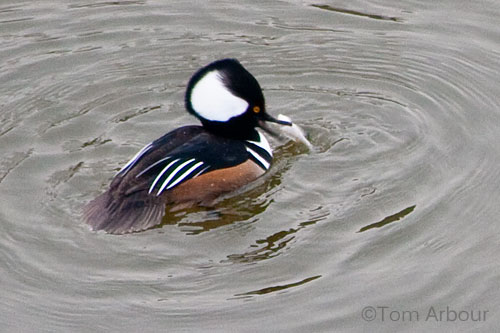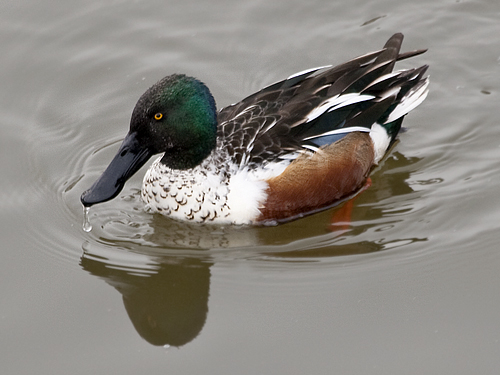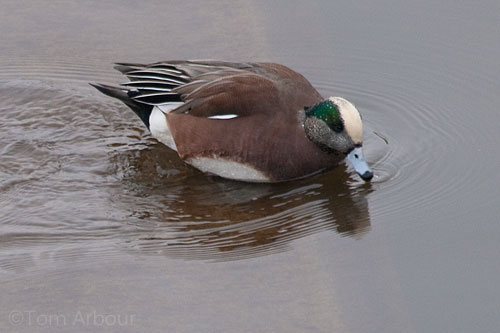For whatever reason, I've always love photographing ducks. These are the species I have photographed.
Showing posts with label waterfowl. Show all posts
Showing posts with label waterfowl. Show all posts
Saturday, January 02, 2016
Thursday, June 09, 2011
Wood Duck Pair on the Olentangy
 | ||
| Columbus, Ohio June 5, 2011 |
Tom
Thursday, March 17, 2011
Delaware Wildlife Area Birds
 |
| Turkey Vulture |
 |
| This is the ROAD to a boat launch, completely flooded! |
 |
| Redheads |
 |
| Canvasbacks |
 |
| Red-winged Blackbird |
 |
| Pintail |
 |
| Redhead |
 | ||
| Ring-neck ducks |
The flooded Delaware Wildlife area is teeming with waterfowl and other birds right now- it's an amazing place to be. Yesterday I was able to photograph Canvasbacks for the first time, one of my favorite ducks.
Happy Spring-
Thursday, March 11, 2010
Drake American Wigeon
I have had several excellent opportunities to photograph American Wigeons this winter, and to be honest, I just love this duck now. That green and white head and salt-and-pepper cheeks and neck really work. These birds beg to be photographed. And the ones at Blendon Woods frequently come close to the observation buildings, allowing great viewing opportunities.
Tom
Tom
Tuesday, March 09, 2010
American Black Duck

I must tell you, that before I moved to Columbus and frequented the Walden waterfowl refuge at Blendon Woods, I had never heard of a "black duck". My introduction to waterfowl was at Blendon Woods, and each year, several hundred individuals winter on the pond that is kept ice free by several aerators that constantly move the water. The black duck looks similar to a mallard, but the males lack the bright green head, and overall, they have a very dark appearance.
The males and females are quite similar, but the best way to tell them apart is to exampine their bills. Males have yellow bills, while the female's bill is brownish.
In a few weeks the black ducks at Blendon Woods will fly north to their breeding grounds. I'm hoping a few more diving ducks join them before the waterfowl migration, now in full swing, is over.

Tom
Saturday, January 30, 2010
The Shoveler Armada



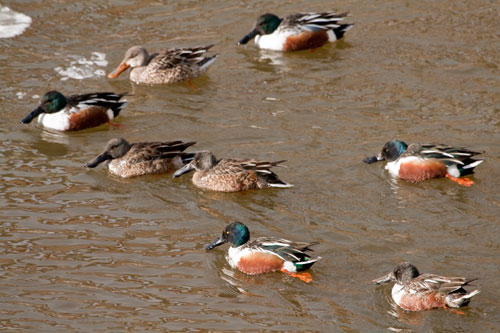
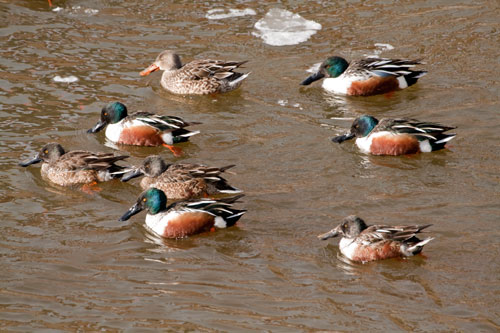



This afternoon below the dam, Hoover Reservoir, Columbus, Ohio.
And if you like ducks, don't miss the upcoming Waterfowl Symposium being held right here in Columbus, including field trips, some of which will be visiting this very spot.
Saturday, January 23, 2010
Wonderful Waterfowl
 The valley of Big Walnut Creek, just downstream from Hoover Dam and Reservoir, part of the Big Walnut Audubon Ohio Important Bird area.
The valley of Big Walnut Creek, just downstream from Hoover Dam and Reservoir, part of the Big Walnut Audubon Ohio Important Bird area. In the pool below the dam is one my favorite spots to photograph birds, and last Saturday this area did not dissapoint. The reservoir was frozen, so the the pool below the dam was full of waterfowl.
In the pool below the dam is one my favorite spots to photograph birds, and last Saturday this area did not dissapoint. The reservoir was frozen, so the the pool below the dam was full of waterfowl.
If you haven't discovered how interesting waterfowl can be, the Hoover reservoir is a great place to start. During migration, thousands of ducks raft on the open waters. And in the winter, when much of the reservoir is frozen, just below the dam is a great place for close encounters with our quacky friends.
Tom
Sunday, December 13, 2009
Pintail!
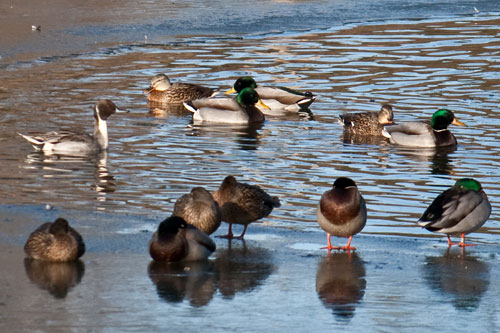 Yesterday afternoon, a beautifully sunny and cold central Ohio day, I stopped at Blendon Woods Metroparks to see what had flown in to Thoreau Lake. There are two great unheated observation buildings at the edge of the lake, and they make bird photography really easy. The building to the right is great for feeder birds, and the left building provides the best opportunities for waterfowl. After scanning the ice free areas of the pond, I could only come up with black ducks, mallards, Canada geese, and two gadwals. But then something caught my eye- a bright white neck. Without binoculars, and without being able to view it with the gigantic metal spotting scope in the building because the bird had positioned itself where it was blocked by the corner support of the building, this bird remained a mystery.
Yesterday afternoon, a beautifully sunny and cold central Ohio day, I stopped at Blendon Woods Metroparks to see what had flown in to Thoreau Lake. There are two great unheated observation buildings at the edge of the lake, and they make bird photography really easy. The building to the right is great for feeder birds, and the left building provides the best opportunities for waterfowl. After scanning the ice free areas of the pond, I could only come up with black ducks, mallards, Canada geese, and two gadwals. But then something caught my eye- a bright white neck. Without binoculars, and without being able to view it with the gigantic metal spotting scope in the building because the bird had positioned itself where it was blocked by the corner support of the building, this bird remained a mystery. In the field, the white belly, brown head, and white neck really stood out. Was it a northern pintail? But it didn't have the typical long pointed butt feathers (technical term please?). Sure enough, after looking at several northern pintail pictures online, I think that is what we have here. But why no long tail? That is the question. Is this a juvenile?
Tom
P.S. This is my 699 post here at the Ohio Nature Blog. Also- We now have 99 followers here. Help me push it over 100!
Tom
Subscribe to:
Posts (Atom)



